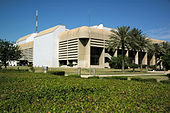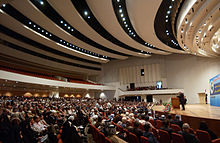- Council of Representatives of Iraq
-
Council of Representatives of Iraq
مجلس النواب العراقي / ئهنجومهنی نوێنهرانی عێراق
Majlis an-Nuwwāb al-ʿIrāqiyy
Type Type Unicameral Leadership Speaker Usama al-Nujayfi, Iraqi National List
since 11 November 2010Members 325 Meeting place 
Convention Center, Green Zone, Baghdad Website www.parliament.iq Iraq 
This article is part of the series:
Politics and government of
IraqGovernment- Constitution
- Federal government
- President (List)
- Presidency Council
- Vice Presidents
- Prime Minister (List)
- Cabinet
- Current Government
- Kurdistan Regional Government
Legislative- Council of Representatives
- Speaker
- Kurdistan Parliament
Judicial- Iraqi High Tribunal
- Governorates
- Districts
Elections- Elections
- Electoral Commission
- Jan 2005 parliamentary election
- 2005 governorate elections
- Dec 2005 parliamentary election
- 2009 governorate elections
- 2010 parliamentary election
- Constitutional referendum
Political PartiesForeign Policy
The Council of Representatives of Iraq (Arabic: مجلس النواب العراقي Majlis an-Nuwwāb al-ʿIrāqiyy، Kurdish: ئهنجومهنی نوێنهرانی عێراق، Encumena Nûnerên Êraq) is the main elected body of representatives in Iraq. It is currently composed of 325 seats and meets in Baghdad inside the International Zone (Green Zone). It is governed by bylaws that can be found here
Contents
History
The monarchy
An elected Iraqi parliament first formed following the establishment of a constitutional monarchy in 1925. The 1925 constitution called for a bicameral parliament whose lower house, the Chamber of Deputies (Majlis an-Nuwwab) would be elected based on universal manhood suffrage. The upper house, the Senate (Majlis al-A`yan) was appointed by the king. Ten elections took place between 1925 and the coup of 1958.[1]
On January 17, 1953 elections for the Chamber of Deputies (also known as the National Assembly) took place. Following controversy over the implementation of the so-called Baghdad Pact, Prime Minister Nuri Pasha as-Said called elections the following year, in early 1954. As-Said dissolved the assembly shortly thereafter and began to rule by decree, but opposition forced him to hold a third election within three years. The second 1954 election was very corrupt, with as-Said's political enemies banned from running, and widespread voter coercion. The assembly was suspended yet again, and in 1958 a military coup deposed as-Said and the monarchy, and abolished the parliament.
Under Saddam Hussein
The 1970 constitution created a republic with an elected National Assembly (al-Majlis al-Watani). However, elections for the Assembly did not take place until June 1980, under Iraq's new military president, Saddam Hussein. Several more elections took place between 1989 and 2003. The new Assembly was largely a figurehead that would occasionally rubber stamp the president's decrees. Elections for its members were not considered free and fair by the international community. Only members of Hussein's own Baath Party were ever elected.
The transitional period
In 2003, Saddam Hussein was forcibly removed from power by the United States of America, the United Kingdom and their allies during the Iraq War. In March 2004 a governing council set up by the Coalition Provisional Authority signed an interim constitution which called for the election of a transitional National Assembly no later than the end of January 2005. This Assembly would draft a permanent constitution which would then be submitted to approval by the Iraqi people in a general referendum.
Elections for this transitional National Assembly (al-Jam`iyya al-Wataniyya) took place on January 30, 2005. The United Iraqi Alliance Party won the plurality of seats with 48% of the popular vote resulting in 140 seats. Eighty-five members of the assembly were women.
Talks between the UIA and other parties to form a coalition government began soon after the election. The assembly had its first meeting on March 16, 2005. After weeks of negotiations between the dominant political parties, on April 4, 2005, Sunni Arab Hajim al-Hassani was chosen as speaker; Shiite Hussain Shahristani and Kurd Aref Taifour were elected as his top deputies. The Assembly elected Jalal Talabani to head the Presidency Council on April 6, and approved the selection of Ibrahim al-Jaafari and his cabinet on April 28.
The Constitution of 2005
Under the permanent constitution approved on October 15, 2005, legislative authority is vested in two bodies, the Council of Representatives and the Council of Union.
The Council of Representatives consists of 325 members elected for four years, with two sessions in each annual term. The Council passes federal laws, oversees the executive, ratifies treaties, and approves nominations of specified officials. It elects the president of the republic, who selects a prime minister from the majority coalition in the Council. (During an initial period, a three-member Presidential Council elected by the Council of Representatives will carry out the duties of the president of the republic.)
Elections for the Council of Representatives were held on December 15, 2005. The Council first met on March 16, 2006, exactly one year after the first meeting of the transitional assembly.
The Council of Representatives of Iraq has the same name in Arabic (مجلس النواب, Majlis an-Nuwwab) as the lower legislative houses of Bahrain, Morocco, Jordan, and Yemen, and as the unicameral legislatures of Lebanon and Tunisia. However, a number of different English terms are used to refer to these bodies.
The Council of Union, or Federation Council (Majlis al-Ittihad), will consist of representatives from Iraq's regions. Its precise composition and responsibilities are not defined in the constitution and will be determined by the Council of Representatives.
2007 Iraqi Parliament Bombing
On, April 12, 2007, Mohammed Awad, a political party member of the Iraqi National Dialogue Council, was killed at the convention centre canteen of the parliament building, and 22 were wounded, in the 2007 Iraqi Parliament Bombing.[2][3]
2007 issues
A group of Sunni lawmakers boycotted parliament in a June 2007 protest of the removal of the speaker, Mahmoud al-Mashhadani, after a series of controversial actions. They returned in July after the speaker was re-instated with the understanding that he would quietly resign after a few sessions. A group of Shiite members also returned in July after a boycott which gained them an investigation into the bombing of a Shiite mosque, along with reconstruction and improved security. The parliament was under pressure from the United States to pass legislation dealing with members of the Baath party, distribution of oil revenues, regional autonomy, and constitutional reform, by September 2007.[4]
Last result
Summary of the 2010 election for Council of Representatives of Iraq Alliances and parties Votes % Seats +/– Iraqi National Movement (al-Iraqiya) 2,849,612 24.72% 91 +54 State of Law Coalition 2,792,083 24.22% 89 +64 National Iraqi Alliance 2,092,066 18.15% 70 –35 Kurdistan Alliance 1,681,714 14.59% 43 –10 Movement for Change (Gorran) 476,478 4.13% 8 +8 Unity Alliance of Iraq 306,647 2.66% 4 +4 Iraqi Accord Front (al-Tawafuq) 298,226 2.59% 6 –38 Kurdistan Islamic Union 243,720 2.12% 4 –1 Islamic Group of Kurdistan 152,530 1.32% 2 +1 Minorities 61,153 - 8 +6 Total (turnout 62.4 %) 11,526,412 100% 325 +50 Source: themajlis.org See also
Footnotes
References
- CIA Fact Book - Iraq
- The Iraqi Transitional Government
- Katzman, Kenneth. “Iraq: Elections, Government, and Consistution.” CRS Report for Congress: January 15, 2006.
External links
Parliament of Asia Sovereign
states- Afghanistan
- Armenia
- Azerbaijan
- Bahrain
- Bangladesh
- Bhutan
- Brunei
- Burma (Myanmar)
- Cambodia
- People's Republic of China
- Cyprus
- East Timor (Timor-Leste)
- Egypt
- Georgia
- India
- Indonesia
- Iran
- Iraq
- Israel
- Japan
- Jordan
- Kazakhstan
- North Korea
- South Korea
- Kuwait
- Kyrgyzstan
- Laos
- Lebanon
- Malaysia
- Maldives
- Mongolia
- Nepal
- Oman
- Pakistan
- Philippines
- Qatar
- Russia
- Saudi Arabia
- Singapore
- Sri Lanka
- Syria
- Tajikistan
- Thailand
- Turkey
- Turkmenistan
- United Arab Emirates
- Uzbekistan
- Vietnam
- Yemen
States with limited
recognition- Abkhazia
- Nagorno-Karabakh
- Northern Cyprus
- Palestine
- Republic of China (Taiwan)
- South Ossetia
Dependencies and
other territories- Christmas Island
- Cocos (Keeling) Islands
- Hong Kong
- Macau
Categories:- Government of Iraq
- National legislatures
- Unicameral legislatures
Wikimedia Foundation. 2010.
